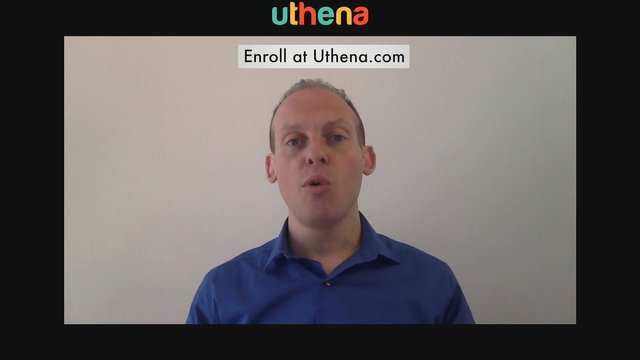
This course is going to give you a complete Amazon sale strategy, comprising of four elements. Amazon search, Amazon ads, Amazon recommendation engine, and creating a very highly converting Amazon listing page for your product, and the combination of those four will help you dominate your niche on amazon, and is the professional way to promote products on amazon resulting in a significant revenue.
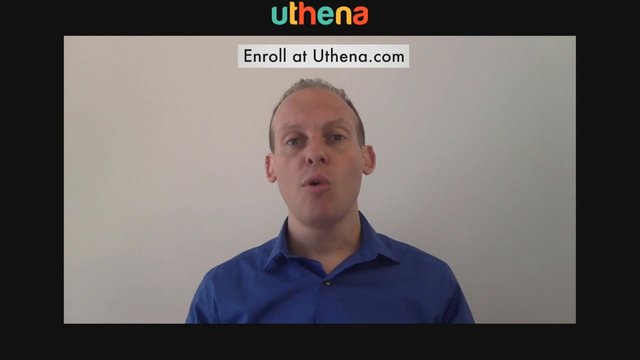
In fact in this course what I show you is, the products that I sell well, and how I sell them and I give you a case study of a client of mine, who in one year went from almost zero to $50 plus thousand dollars a month in revenue. So this are the two examples I give through our course so you can see actual products being sold and what’s effective and what’s not effective.
My name is Alex Genadinik. I am a long time instructor on Udemy and done over a hundred courses, and this is a great month because this one has a complete strategy. So if you are thinking of selling on Amazon, or you have tried selling anything and it hasn’t worked, and that is the case for many people. It is okay. That’s why we have this courses, so that you can create some strategies to try. You can see what maybe didn’t go right and you can reverse course to make it successful.
So, if you’re thinking of getting into amazon, if you have been trying but struggling, or if you have some product that you haven’t even thought of selling on amazon but maybe you are trying to sell from your website and that struggling, this is the ideal course for you.
Sign up for this course and let’s help you, dominate your niche on Amazon.
If you will enjoy reading and contributing to the discussion for this post, will you please join us on the YouTube video above and leave a comment there because I read and respond to most comments on YouTube?
If you find anything helpful in this video or funny, will you please leave a like because you will feel great helping other people find it?
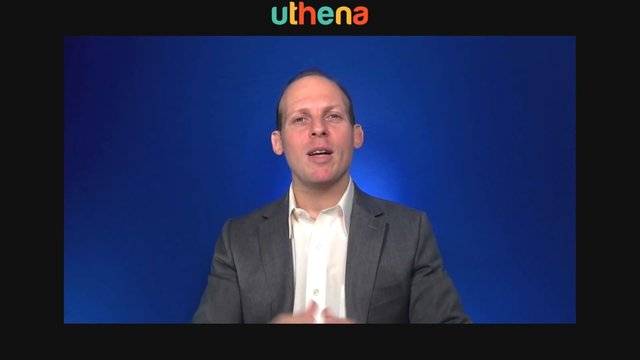
Welcome to the course my name is Alex Genadinik and I will be your instructor. I sincerely appreciate the time and trust you have put in me and this course. This video is a brief introduction to me and the course, so that you can understand what to expect from the course, so that the course meets your expectations and at the end you’re happy.
A little bit about me, I am a long-term Udemy instructor. I have over a hundred courses that I teach with over a hundred thousand students and I make sure to be as available for students as possible. My goal is to answer 99% of emails, comments in the course within 24 hours, and I also regularly run office hours, where you can talk to me and get advice in a conversation. So, I really really go out of my way to help students and support students.
Now, what is this course about?
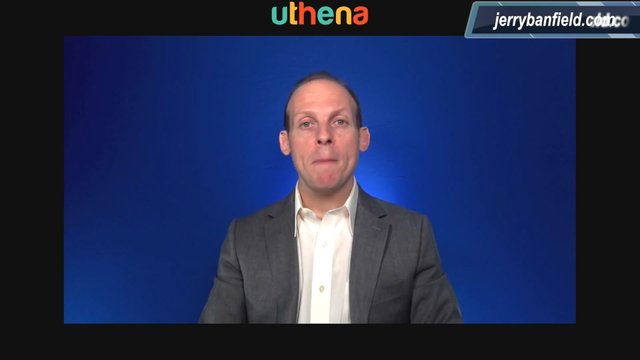
So, I have been successfully selling on Amazon for many years. I sell books and I have a client who specifically sells a physical product, and this course is a case study of these two situations, right? Books and physical products which covers a big scope of Amazon, and we’ve both been successful.
In fact my client has created a seven figure plus business, like literally from zero to that and I have been with him every step of the way. So, it’s a rich course, I really explain the most effective way to sell. What I don’t explain is how to set up your product on Amazon, the registration and all that stuff because I explained the hard stuff which is sales.
Sales is the hardest part and that’s what this course really zeroes in on, and it explains the most effective ways to sell. So, you never have to look past this course if you want to dominate Amazon. Everything is here with one caveat. You have to execute the strategies really well, because most niches are competitive.
So, quality of execution is gonna really matter, but the strategies, they really work.
So, with that, let’s get started with the course.
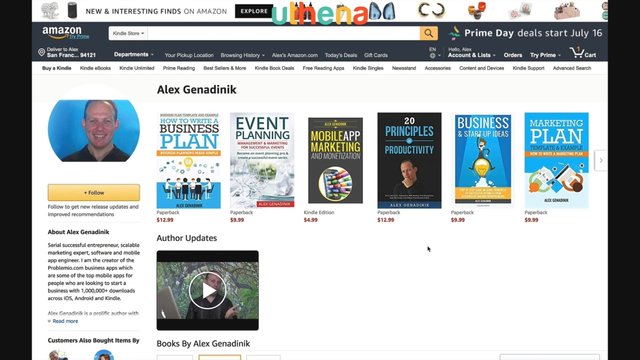
In this video, I wanna show you the two examples that I will be using in this course primarily, and this are two very different examples. This are my books and this is my book page.
As you can see I have a lot of books on Amazon, and I sell some of them successfully and some of them not so successfully. We will talk about it. I have a successful client of mine, who sells a very different product, the physical product.
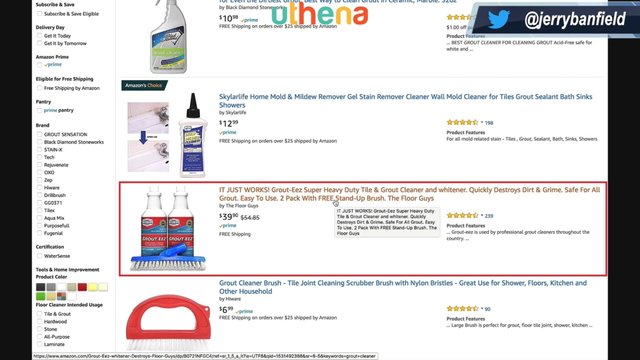
It’s a cleaning product, and he makes over $50,000 in some months and he is growing. So I got him to do this in about a year. So, he went from having no products on Amazon to making $50,000 a month on Amazon.
So, I will be using two different types of products and basically this examples that I will be using I have insider information to them. So, I will be able to share to you everything that went on behind the scenes and how I got them to sell like they do.
Now immediately, I wanna set somethings very very clear. Most people when they try to sell products, this is exactly the conversation I have with them.
They say, "I tried promoting on Facebook, Instagram and I tried running Ads, but nothing worked."
And when they say Ads, they don’t mean Amazon Ads actually, they usually mean Facebook Ads campaign and Google Ads campaign which have a time and place, but in this case, what I am going to tell you is that most products are sold through search, and on Amazon I am going to add to that statement. I am going to say most products are sold through such and when people search, you see the product pages almost always have other books.
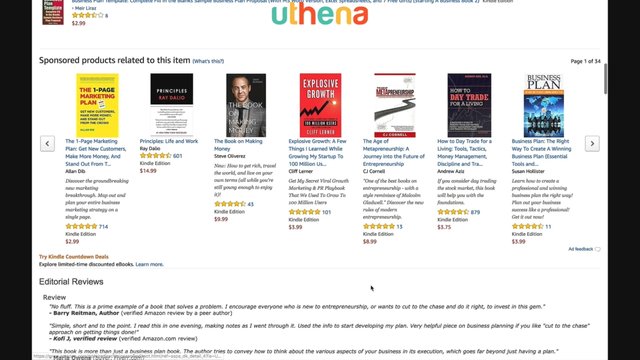
You see how many other Ads there are for other books, that amazon actually places on your sales page? Its endless, right? All of these books, okay? And if your book gets recommended by Amazon, then it gets discovered by people who might not necessarily discover it and it might get sold.
Your Job is to make sure your book, gets recommended on as many pages as possible, because Amazon is vast, and they have thousands and thousands of book pages, and if you get recommended on other pages of other books that is going to give you a lot of extra sales. But don’t forget that people actually want your product and the people who want your product, what do they do? They search for your product. Just like for my book, they might search for 'business plans'. For my client they might search for 'grout cleaner', and they will find grout cleaning products like this one right here.
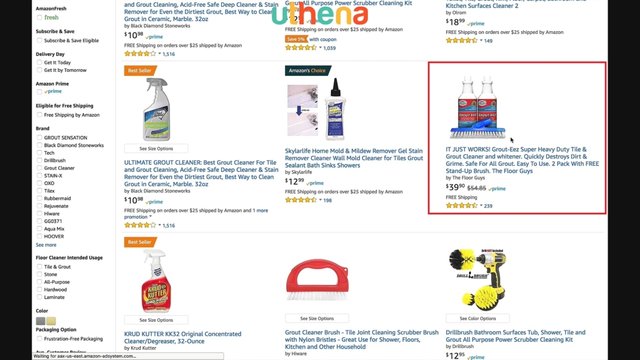
That’s where most of the sales come from. So, SEO on amazon is the start of it all, because that is the easiest way to begin your sales, and once you have sales you start being recommended on other pages.
For example, if I click a competitive product then you will see that he’s got my clients products recommended on this page, and that’s the job.
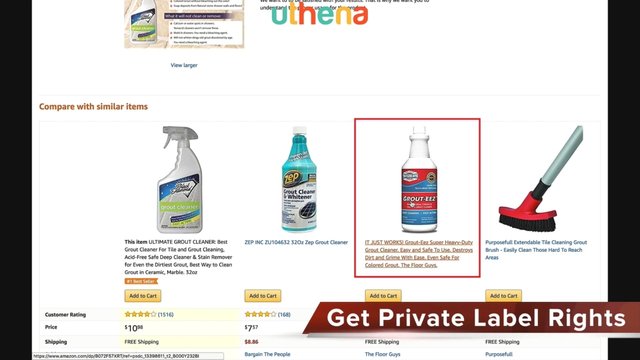
Not Facebook, twitter, social media, Instagram, Facebook Ads. Not that. You should think Amazon search and Amazon recommendations. Now, of course Amazon has added sponsored listings.
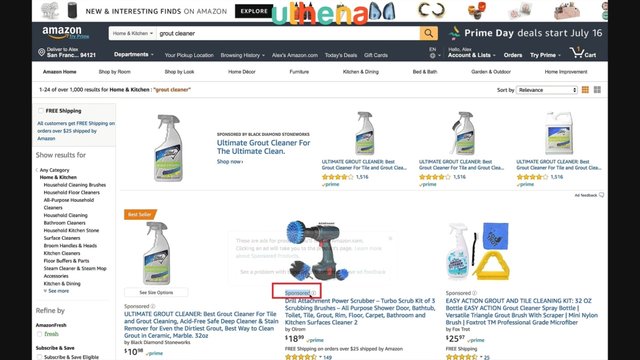
Those are ads. So actually Amazon Ads are also a fantastic way not only to boost your Amazon SEO, and will talk about later, but also to get right on the front of the search area and that is also a very good way to make sales
So those three. Amazon Ads, Amazon search and Amazon recommendation. That’s where a huge book of your sales will come from, and that’s where your initial focus needs to be
Now that you understand the importance of search, for selling products, I want to explain to you the three key components to any SEO process.
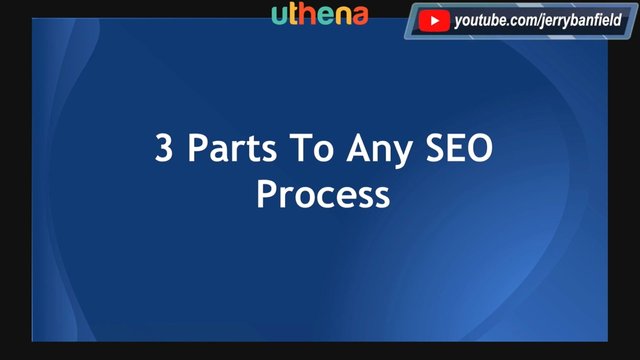
Two of them you will be able to do literally today, and they will get you a pretty long way. One is the long term, the other part of the three components is a little bit of a long term thing. I will explain it.
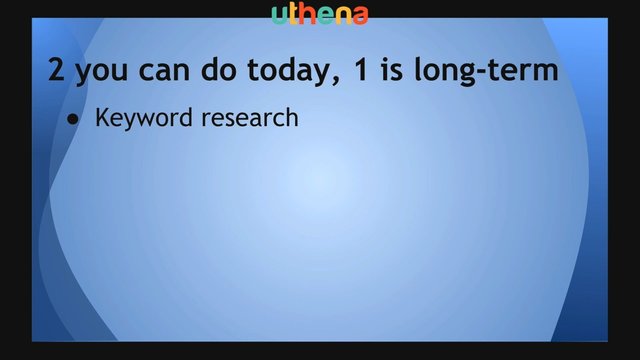
The first one is keyword research. Basically what are people searching? We will go over this in more detail later but for now I am just explaining this at a high level. So, the keyword research is basically the keywords people will search. Now if people are searching for Grout cleaning product, okay. Perfect. Because that is an exact perfect match for what my client is selling. But if people are looking for like just cleaning product, then there is a much smaller chance that my clients’ product will match the needs of the person searching.
So, there is a lot of sensitivity in getting the exact keyword right and if you get the keywords wrong , some examples of where you can go wrong with the keywords are, if nobody is really searching those keywords. You just kind of came up with them but didn’t verify that hey, people are actually searching. Or if those keywords are so competitive that you are competing with like literally million and billion dollar companies, and you just cannot out-compete them and so you end up never ranking and its almost as though you don’t even have a product listing because nobody discovering your product listing. That’s a problem. Or if you simply chose keywords that they just are not getting you potential buying traffic. Maybe they are getting bouncing traffic.
We'll talk about how to distinguish later. But essentially, there's a lot of places where you can go wrong with the keywords. And if you go wrong with the keywords, nothing else you will do in search is going to help you because guess what, you got the foundation wrong.
So this is a very important thing to get right. On the flip side, if you get this totally right, this is a very money making lucrative process because you're literally identifying as many as possible paths for different people to find you.
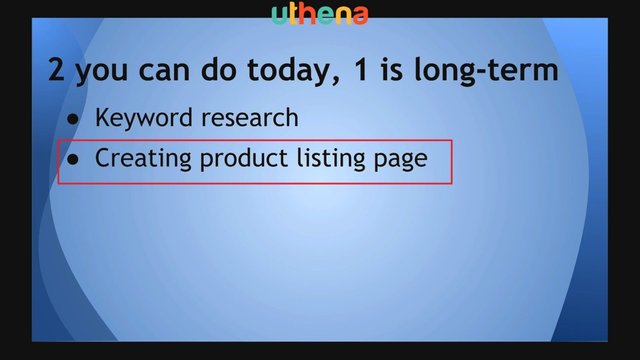
Once you get your keyword research correctly, the next thing is to create an ideal product listing page that uses the keywords, targets them appropriately, and at the same time still is compelling and reads right for the people visiting your page.
For example, if my client just said, you know, ground cleaner, ground cleaner, ground cleaner, ground cleaner, and keyword stuffed, that would not be right, because It doesn’t read right for the actual consumer who's visiting the page and that consumer wouldn't buy. They would be turned off.
So the right product listing has to have the SEO keywords, but also it has to be compelling for them.
Those two you can do today, literally.
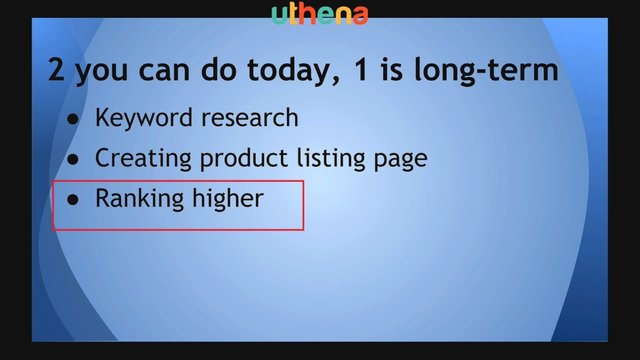
That thing that's going to take you a longer time to do is maybe you'll launch your product page today but maybe it's going to be on page 10. And literally when we launched the grout cleaning product, it literally was in page 10 and it took a while to get to page eight, page seven, page five, page two, page one, and then on page one from the last one to the middle, towards the top.
And most of the sales generally for most products will happen on page one and near the top of page one. And that is a process that will take sometimes weeks, sometimes months. And it really depends on how fast, really depends on the quality of your execution of this.
All the money essentially, all the sales is made when you are ranking really highly. That was really a huge difference from my grout cleaning client. When he was ranking even on page two, he wasn't making almost any sales. But once he got to be number two, or three or four for his search, he started making, you know, like five figures a month, which is a tremendous difference.
So those are the three major components of a good SEO strategy.
Now, we're going to get into how to execute all of these.
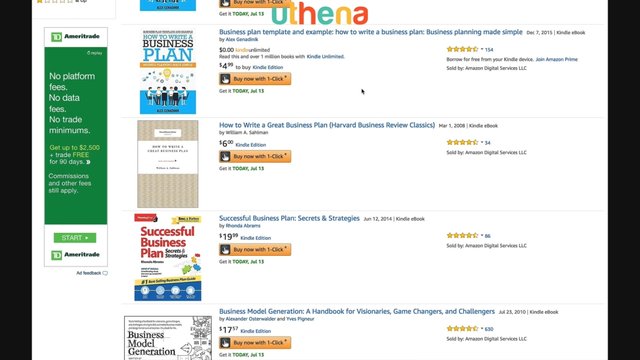
When it comes to placing the SEO keywords on your product listing, the important places to have it is your product title. Sometimes you have a product subtitle when it comes to books and other types of products and the keyword field which is the behind the scenes field that you fill out.
Also when it comes to product listing the keywords in the description, they don't matter as much. So really focus on making everything else, focus on being attractive and highly converting. Now let me explain what I mean by that.
First, conversion actually starts not from your sales page, but from the search results listing page that Amazon serves up.
So as you can see from the example here I searched for the word business plan and here are a few first listings.
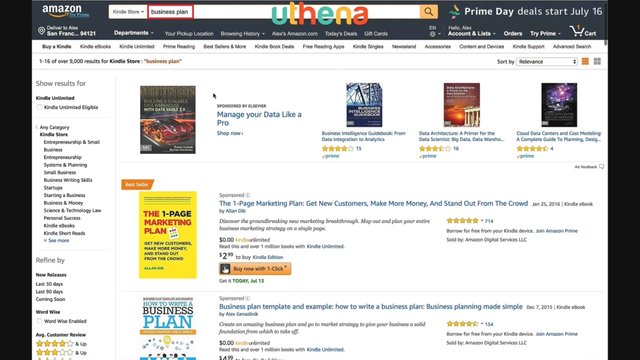
The first two are ads and the first organic one is mine and you can see I'm promoting this.
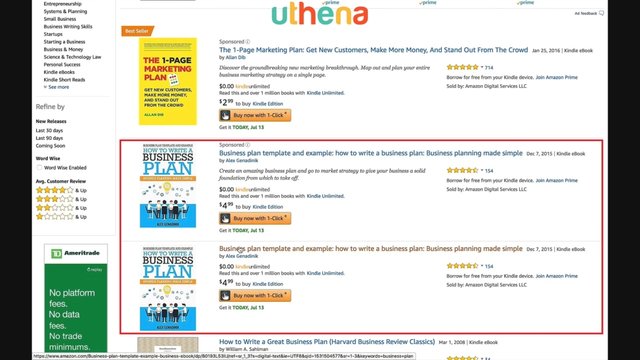
First of all, I'm reinforcing my book here. So there's a lot more real estate for my book. There's more chance that people will opt for my books either through the ad or through the organic listing than otherwise. That's number one. But even though that wasn't the case, what you want to have is an attractive title, because that's the first thing people see.
And as you can see a few of the elements that make people click, for example, attractive reviews, and a little bit of other elements. But really, it's just the big font is the one with the title, a nice picture for your thumbnail of your product and good reviews. That's the bulk of the clicking decision that a user goes through. And this is really important because if you think of, what does Amazon care about? They want to serve up the products that get the highest click through and eventually highest sell rate, because that's how they make money only when they sell.
So they want to show most relevant products. So you want to make sure that the keywords you choose are going to be the ones that are going to have the highest chance to buy. So for example, when people search for the word business plan, and there's a competing marketing plan book, even though this is a very popular book, it can't really compete in organic listings.
It's only right here, just because it’s a different topic.
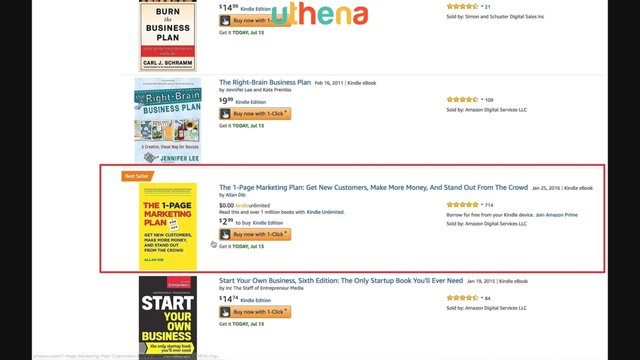
So the more of an exact match you are for the search, the more people will actually click through on your listing and land on it, and then they'll have a chance to buy. So when we click on the listing; we've covered the keywords in depth. I'm not going to talk about that now.
But what I want to emphasize now is conversion.
And the way I want you to think about this is, everything that you are able to edit on this page.
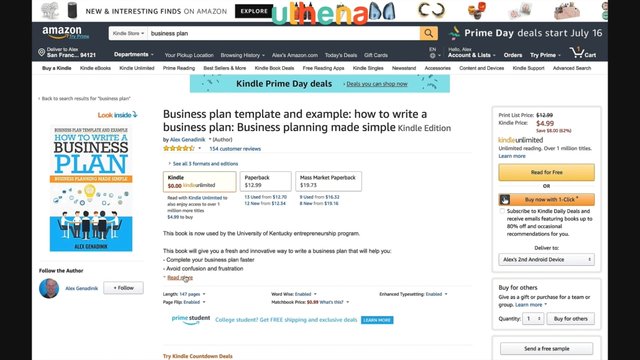
It shouldn't be there, unless it boosts your conversion. The title should be as attractive as you can make it. Obviously balancing out the keywords, the description should be as attractive as you can make it, you want to give yourself credibility, you want to make the product that you're selling, you want to emphasize and show the customer how different their life will be before and after they get your product. In the case of the grout cleaning product, they might be suffering because they don't have a good clean product and they have to scrub and scrub and scrub and this product really makes the scrubbing much easier because it gets rid of the problem. The grout. Dirt. So you are basically making the cleaning life of the people easier and cleaning is faster. So it's worth the price.
Now the business plan book, obviously, they'll have a good business plan and strategy at the end of the book and you want to establish credibility. For example, here I say, Oh, this book is used by University of Kentucky entrepreneurship program. In fact, a few universities have bought this book. So, that's something that I felt brings credibility to the book.
It's unique in that regard and then some things on this page you can't control. Obviously, Amazon tries to sell stuff.
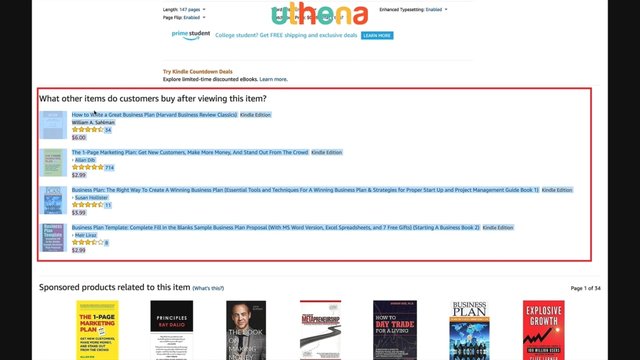
You can't control that. But some things like editorial reviews for books, you can add that.
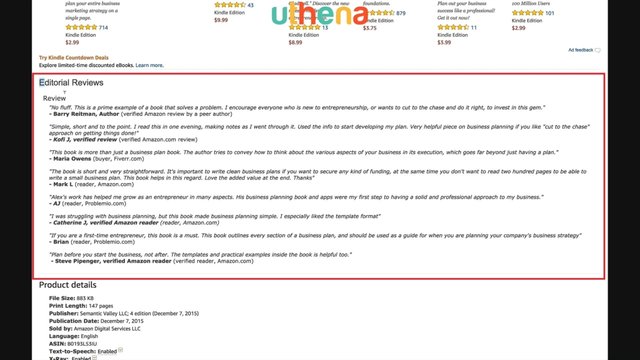
And very importantly for product details, you can have control over all these things.
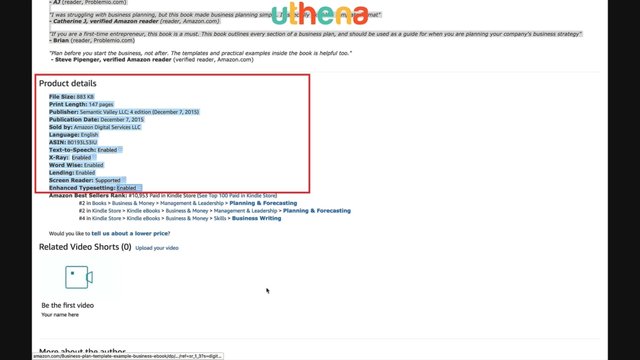
And what you always want to have is make sure that your ranking high in the categories. That always helps. It's you know, obviously difficult. But when you can do that it helps. If you have more than 100 pages, more than 200 pages, it is even better. Bigger is not always better. But when customers buy, that's the effect that bigger has. It does have a relationship with more buying.
So under 100 pages, you will have slightly less buying. Over 100 pages, you will have slightly more buying if everything else is the same and over 200 pages you will have even a little bit more buying. I know bigger is not better. But it does correlate in terms of buying. Go figure.
And then you want to have a credible biography.
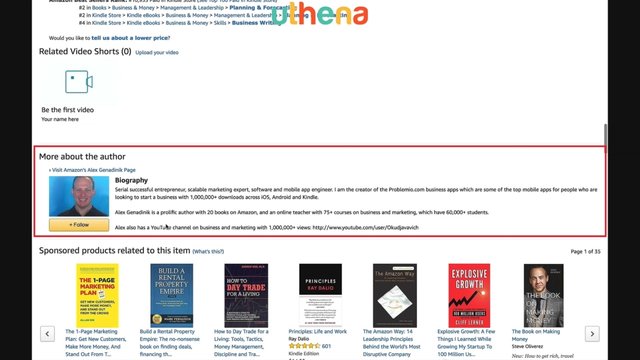
And of course you want to have good reviews. In my case, my product is rated 4.6 out of five.
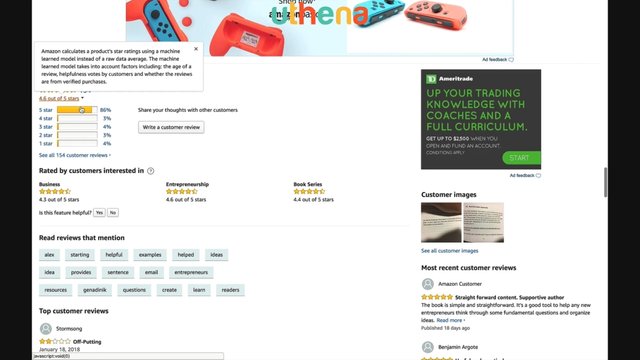
What you can do to influence the buying decisions of reviews, for example, is to ask your friends maybe to upload, and this is something that I should be doing, your good reviews. Because for some reason six people found this review helpful where it's like a bad review, and actually works to decrease the sales. So what you want to do is mark, this is as not helpful, and have your friends mark other reviews as helpful.
I haven't done that much of it but I probably should do more of this. And you can always leave a comment. I've actually left comments on bad reviews. I don't know why it doesn't show up. But your comments should always be professional understanding and explaining always in a pleasant professional manner. Always explain, "Hey, maybe you missed my goal, you missed my point. This book is very good. I worked really hard for a number of years to update the book, improve it in different aspects of it."
So I do stand by the quality of this book. I disagree with the reviewers but nevertheless I can't control how Amazon decides. Two or three of the very few bad reviews that I have, for some reason they put them there. I think they try to show a balance because they show some five stars and some one stars just to influence people's decision equally, but I don't know why they have the bad ones on top. Thanks, Amazon. Or no thanks, Amazon. But you can combat that by getting more good reviews, leaving professional comments and even sometimes reaching out to people reviewing. Because you can click these people and sometimes it gives you a way to message them and sometimes you can just find them.
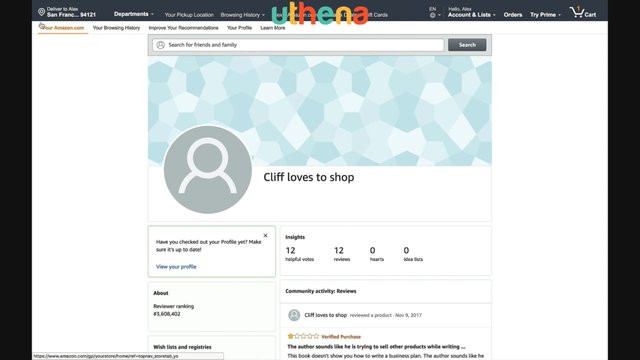
This person's name was Clifford Billings, which is like the first. That's his name. So Arthur Billings or whatever.
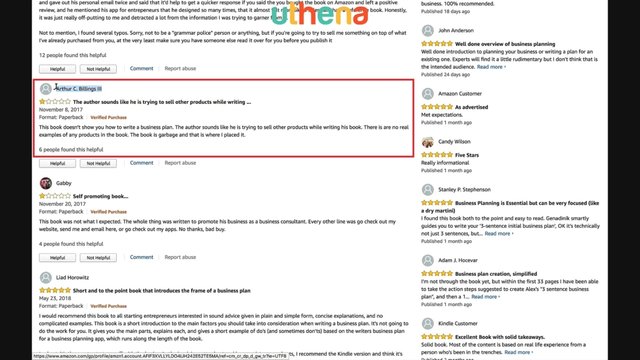
So, you can even find them online and message them. Sometimes that helps to, you know, just get them engaged and maybe they can reverse the review.
So once you have make your listing as highly converting as possible, and everything you do, will boost your sales just a little bit, guess what that does? The more sales you have, the more total dollar amounts you have, the more you will start to start to influence how your book gets recommended. So your reviews, your total sales will start to influence how your bill gets recommended and this is where the beauty of Amazon happens.
Because your ranking in search and your efforts to make your listing as highly converting as possible, that combination will result in you ranking higher, getting sales, you'll start getting reviews, and from those purchases and from those reviews, you'll start that acceleration of positive signal that will get Amazon to promote you more on the listings of other books.
For example, when I click this business plan book, very likely, my book is recommended here. My book is recommended here. You see.
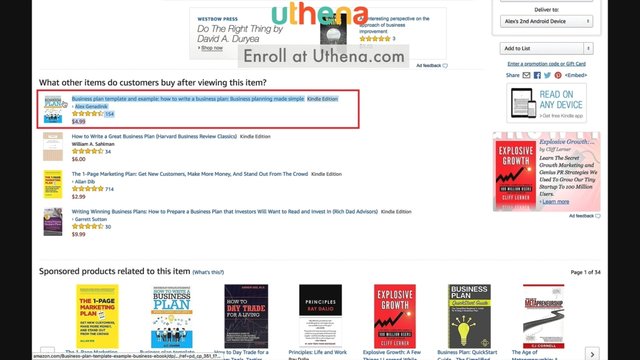
So it's very common that my book gets recommended in other places and so I get more sales now from not search, but the recommendation algorithm of Amazon. And so after search, remember, this is the second place you want to target in your quality of execution of your search and SEO and conversion directly flows into your success of how much Amazon will start recommending you.
So that's the beauty of combining all these things.
Introduction to Amazon Reviews Section.
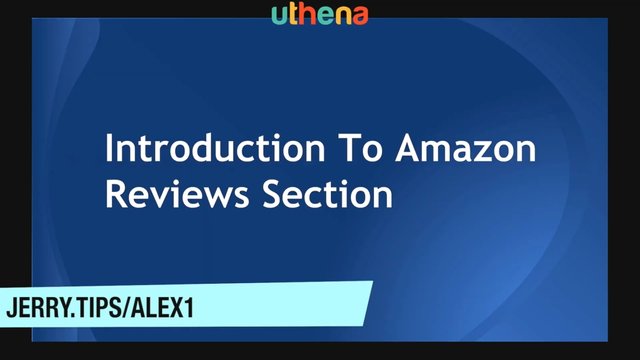
This video is an introduction to the next few videos, which is the whole section about getting reviews on Amazon.
Why am I going to spend so much time on reviews on Amazon?

Because no one buys products that don't already have reviews. It's that simple. Buyers want to see other people who have bought products in the past and liked it. We are a herd animal. We do what other people do. We don't want to be the first ones to try stuff, not risking our own money.
We want to know that something is good. We need proof. And reviews are social proof. They are very strong. In Amazon, you need verified reviews, which means essentially reviews from people who have actually bought products. Almost anyone can review products. You don't have to actually have bought product. But the people who have bought on Amazon get a sticker that says the review has been a verified review and those reviews boost your organic Amazon rankings. Those reviews help you rank higher, which means more sales from Amazon.
That's the whole game almost entirely. And one of the biggest mistakes early sellers make is they post their product and they think they're done. But they just started. They need to get reviews so that their products can rank and when the product starts ranking, the product starts getting organic sales.
It's like that with almost every product category. There are some exceptions, but it's like most product categories are a fit for this pattern. So if you just posted your listing, do not relax, start getting reviews, and that's what the next bunch of videos are going to be about. If you don't do this, you're not going to have good results in Amazon.
But if you implement this really well, you're going to have amazing review on Amazon and you're going to open yourself up to tremendous potential.
In this part, I want to show you a distinction between the kinds of reviews, you can get. Verified and not verified reviews.
You might have seen this before. But I just want to show you again. I'm going to click on all the reviews here and what I'm going to do is I'm going to scroll the reviews, and I'm just gonna say most recent. What you'll see is all of them have these verified purchase.
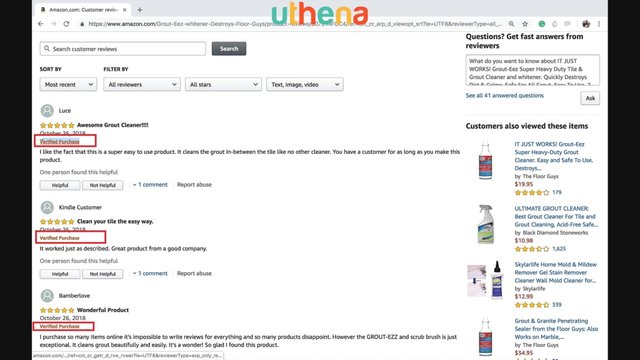
So these Amazon thinks that they are more legitimate reviews, and they show that to the customers.
What does that mean for you to be verifie and why is it so important? It is actually very important.
If you get a review that is not verified it says that either that person didn't actually buy the product through Amazon or if they did buy the product, maybe they got some kind of a discount, either free shipping or discount on the product.
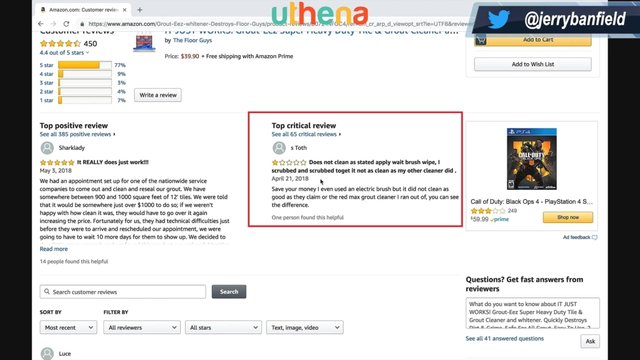
So maybe that person was like a friend who got a discount. So maybe it's not a real review. So when you get their reviews, the reviews that actually help to boost your rankings are only the verified purchase ones.
If you get a review that doesn't have this sticker that one will not affect your rankings positively or negatively. It just doesn't affect it. But it does affect your overall star rating.
So if you get good reviews that are not marked by this verified purchase, it still helps you because it makes you overall score increase which is actually good for you. A 4.4 sells better than a 4.3. That little difference actually makes a difference in sales. Not a huge difference. But it does make a difference. For every 10th of your star rating does make a difference in sales. If it's higher, you make more sales. If it's lower, you make less sales. So be very vigilant on that.
So every review, if you get a good review, verified or not verified, it will help you make more sales. But the ones that really help you to boost rankings make sure that they are verified. And again to make sure they're verified that person has to buy the product and it can't be through a discount either on the shipping or the actual item price and then you'll get your verified reviews from customers. With a lot of good verified reviews, you'll start to rank higher.
In this part, let's talk about how to get reviews on Amazon for physical products that are not necessarily books.
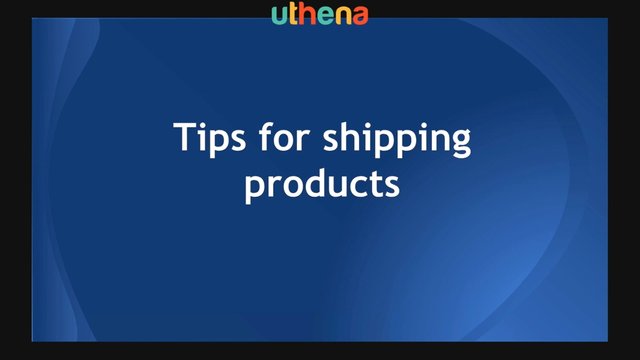
So let's talk about what you can do. First, you should add a note in the shipping package or inside your manual. Sometimes it can be a one page printout or it can be something inside your manual and you have to explain. First of all, your explanation has to be fantastic. Because if you don't explain well people will get frustrated, and they are not going to use your product correctly. Even if you think it's dead simple to use, guess what people will find ways to use it incorrectly, because they're just going to rush right into it and who knows. We don't know what their situation is. But a lot of people no matter how good your product is, or how clear, they're going to start having problems, putting it together, using it, breaking it, whatever.
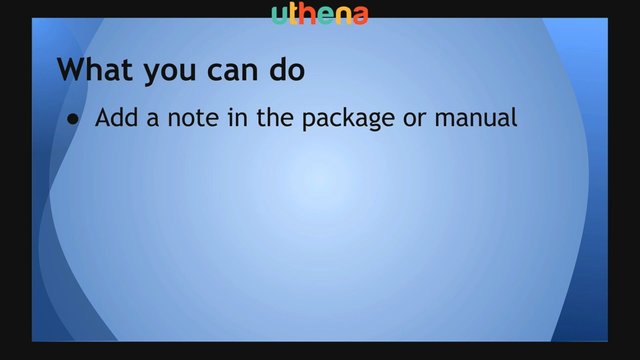
So you have to create a manual or at least add a one page slip to the package that you send explaining really clearly how to use things correctly. Sometimes in your manual if you explain what this is for, what you can expect, that can decrease bad reviews because people won't use things incorrectly.
For example, I have a client, he's got a grout cleaning product, and it's a really good product but the problem is people are using it incorrectly when they're trying to clean and then they're trying to blame the product instead of themselves.
So the more descriptive, your manual and instructions and the more clear they are, the less people will get frustrated and leave bad reviews. Of course, the more they'll be less frustrated, the more happy they'll be, and then they'll leave better reviews.
So it's not just not having bad reviews, it's actually going to reverse the bad reviews and maybe turn those potential ones into good reviews because your product will finally work as advertised to those people.
Now, some people will not be getting it. Some people no matter what your manual, and instructions are like, they'll be like, you suck. Your product doesn't work and you'll find later that probably they just didn't read the manual or package or anything. They just are basically blaming you. In those cases, make it really clear that you offer really good customer assistance. It can be through the phone, can be even through Skype, can be whatever you want. It's your business. I suggest and recommend that the closer you get to the people in the conversation, the better. So Skype is something that I really prefer. Because they can show you what's wrong with the product, you can talk to them, you can see the emotions on their face and you can tell when the emotions on their face changes from frustration, to happiness and relief of their problem.
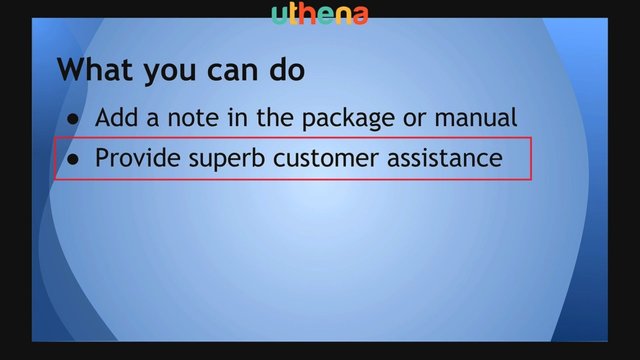
Because if you can provide help, I know Skype is very time consuming, but if you can provide help on Skype, or over a phone or you know phone is better than email, because on phone, at least you can hear them, but when you can sense that you have provided the help, that's the best time to inquire, you know, get a feel for if they're okay with leaving you a review.
You can ask, "Are you happy with the product? Is this working as you expected?"
Those kinds of qualifying questions and if they say yes, yes, yes, I'm happy, happy, happy, then you asked for review. Not before that. Because if you ask for a review before that and be too eager about it, they might not be ready and they might get irritated by you asking about the review and say all they care about is the review. Wait until they're happy with you. They love you then ask for a review.
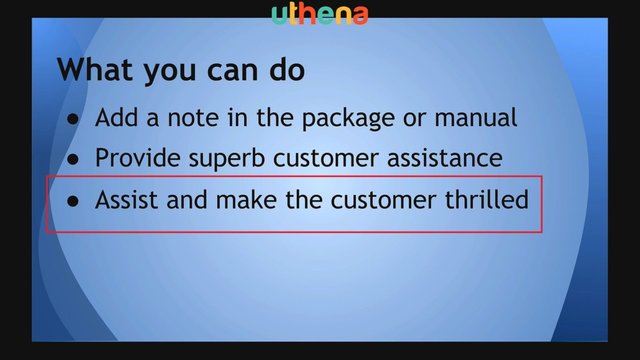
So make the customer thrilled first. There is no ask until they're thrilled. And what you're looking for is the moment at which they're thrilled. That's the best moment to ask for a review. Almost no other moment.
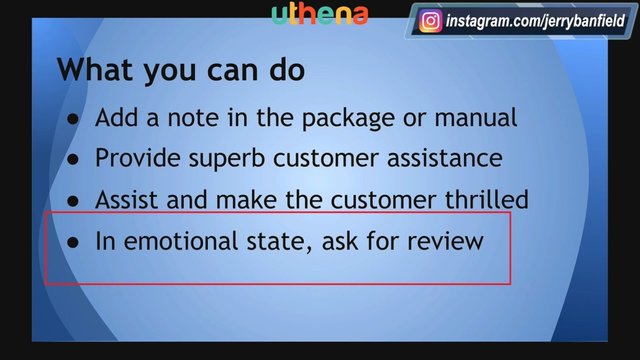
Okay. And the thrilled moment, it is an emotional moment of happiness, and joy and that's when it's really good to ask. So if you follow this formula of how to structure your manual and instructions and your customer support, this will turn a lot of your negative reviews into good reviews, and it will turn your non reviews into good reviews.
The goal to sell more products on Amazon is to get them to rank in search for relevant keywords and of course to get recommended.
But how do you do that?
One way is to run ads. So let me show you an example of how I do things. So for example, I'm trying to get one of my books to rank for the word productivity. It's a very competitive keyword and I'm running an ad for this, as you see.
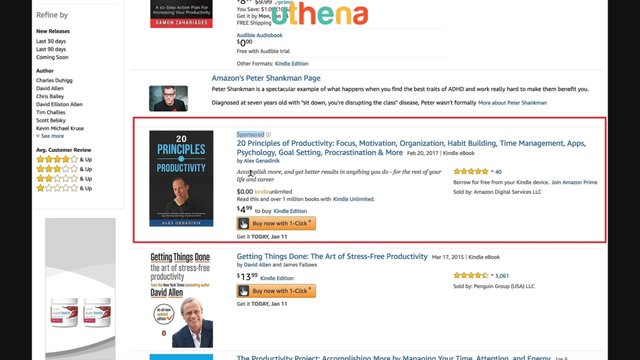
This is sponsored. An ad. I wish it was that high. I am working towards getting this book to rank. Now, the organic listing is somewhere in the middle of the first page and I'm struggling and working very hard to rank it higher. So what happens? I'm actually running ads as a way to get more sales and more reviews and more engagement so that not only this book doesn't fall down because all my competitors are also competing against me and trying to outrank me. So on the one hand, I'm trying to stay up in the rankings and not fall down, on the other hand, I'm trying to climb up the rankings and rank higher and higher long term.
And at the top some books are very competitive. I mean, this book is crazy. It has 3000 reviews.
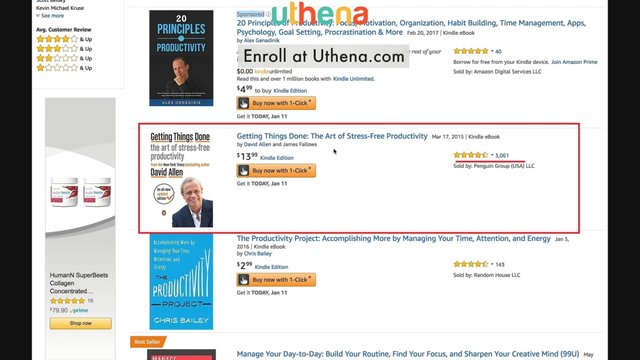
So how do I do that?
So let me walk you through some ads strategies that helped me actually rank a little higher and get recommended more.
There are multiple ways to grow with ads. Of course, everybody understands, you can spend $1 on ads and earn $2 and if you can do that, you can spend a million dollars because you make 2 million back. So that's a no-brainer. Everybody gets it. No problem. But what about spending $1 to earn 99 cents.
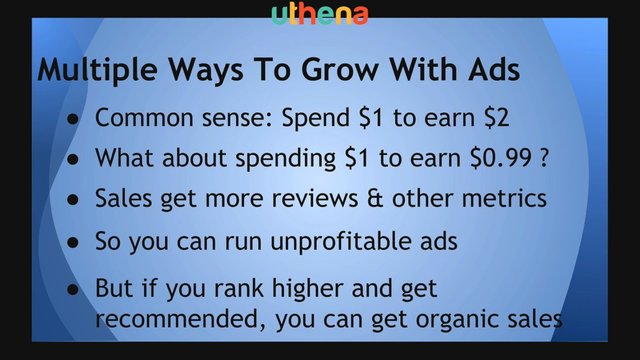
You will think if you spend a million dollars, you'll lose a lot of money. You can't do that. But maybe you can. Because when you make sales, you get more reviews, and you boost your other metrics like engagement metrics, all that stuff. So you don't just get 99 cents, you get 99 cents and reviews and metrics and more engagement. And so what happens is you can run unprofitable ads. Slightly unprofitable ads are okay because they can help you rank higher. All those metrics, extra reviews, extra engagement, will help you rank higher organically and eventually get recommended more and that will make up for those short term loss. So you can run unprofitable ads.
How unprofitable you ask? Well, it partially depends on your appetite for loss because you do have to take a short term hit. In my case, I'll show you what's happening with this ad for this book. So this is the ad, we can drill down on it and see that in the last 30 days, I spent around $300 and I earned around $480.
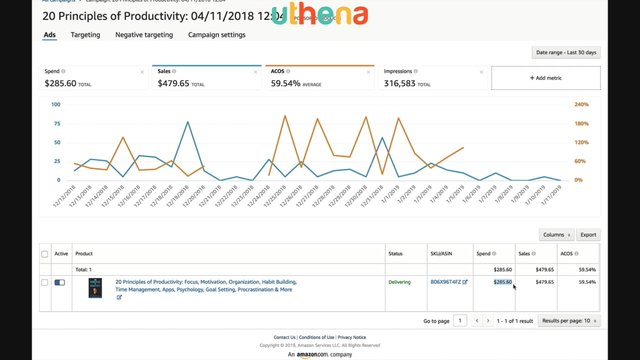
Now, the earnings and the sales are not completely clear, because its sales. Yeah, but Amazon takes a cut. So I don't get to keep all of this. I get to keep about 70% on the Kindle and a slightly different number on the paperback depending on the current price of the book and all this.
The ads are probably running slightly, break-even, slightly profitable, but it wouldn't matter because it would almost behoove me to run this to spend 20 times more, right now, if I can get 20 times more engagement, 20 times more metrics, I'm going to rank a little higher, right? That's going to boost me.
So that is really the goal. So that will be the strategy for this type of situation. When you launch a product. One way to give it a boost is to run ads for it. As you can see, this is one of my books and for the word productivity, which I'm hoping to eventually rank for, this book is not ranking as you see, organically.
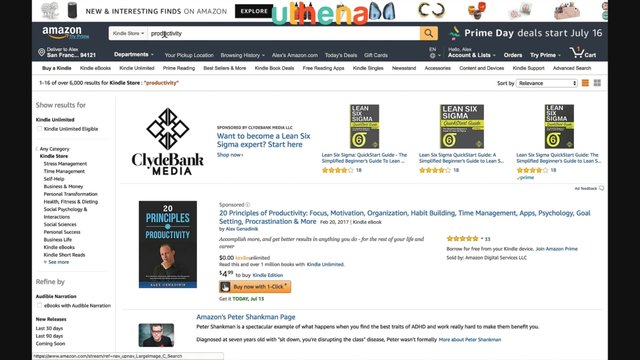
I just did the search and sadly, it's not ranking. But I have an ad running for it. And this ad is a way to get you more reviews, more sales, more money so that you see when I scroll all the way down, this is the organic listing of this book.

And at least it's kind of coming back up. And what happened was, in the beginning, when I launched this book, it was like on page five, or 10, wherever and I had to basically promote, promote, promote, promote and this is a competitive, difficult niche to promote and into ranking. So it took time and I had to basically scrape up sales from social media, my email marketing everywhere else. And the consistent thing is the ads because the ads are running every day, and I'm able to get sales from it. So here's the thing. This ad helps you get sales. I'm going to show you how to start setting up your ads. But when you look at ads, there’s a couple of ways to look at ads. Basically, you can look at the ad and say, Hey, I'm spending $1 to earn $2. That sounds logical and reasonable. Good.
What about that spending $2 to earn $2? Does that make sense to you? Well, it makes sense to me. Because if I can spend $2 to earn $2, but at the same time, if I'm getting sales for this book and the organic listing is going up, up, up, up up, then really what I'm doing is I'm boosting the listing of the organic sale, and through that I am getting my organic sales.
So it's not really $2 for $2 of sales, its $2 for $2 of sales and more organic listings via the ranking. Okay. Now let me ask you another question.
Does spending $2 to make $1 make sense to you?
Okay, so now you're spending more than you're earning. Okay, this can still make sense. Because f this listing, the organic one eventually ranks very highly, then guess what happens? You get to make a lot more money from the organic listings. And sometimes even spending $5 to earn $1 can still be profitable. You see directly, it's totally not profitable. But indirectly, you're influencing the search algorithm. That's the point. So if you influence the search algorithm enough, depending on your appetite for spending and for risk, because it's no guarantee that you're going to end up ranking, then you can spend way more money than the book is actually ranking in the short term in order to benefit long term. And this is the beauty of ads.
If you can do this, if you can weather the short term storm, it works.
Now, the good news is that we're still relatively early in the life cycle of Amazon ads. So it's actually not that hard to spend more than you earn. Spend less than you make back. Meaning directly profitable ads.
So let me show you how to get started.
First of all, you go to Amazon. Its Amazon marketing services. So it's basically ams.amazon.com and we're just going to go there. And it's going to require you to sign in.
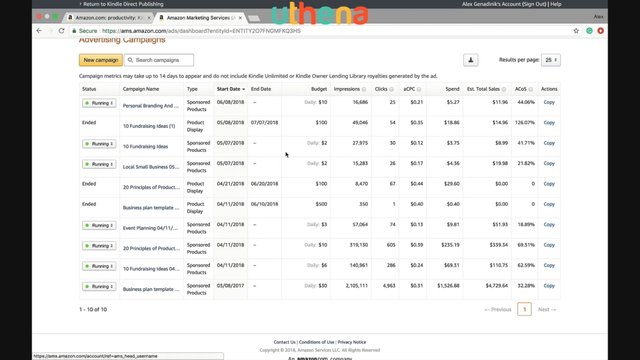
For me, I'm already signed in, and you sign in with your basic Amazon profile and in the next video, we're going to begin to examine my ads and I'm going to be showing you what's working and what's not working because I have a complete suite of ads that are running, fully ran, continuously run, different ads and I'm going to show you what each one of them does, and how it works.
In this part, I just want to introduce the next section, which is the next few videos that we're going to cover. That's going to be on selling using social media.
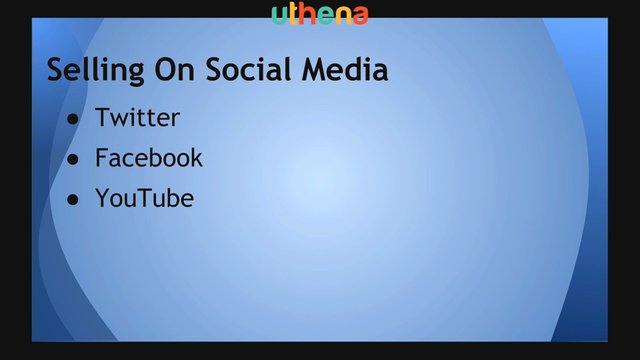
And these are some of the same, you know, the usual suspects, right? The Twitter, Facebook, YouTube. These are sales you can make pretty quick and early.
We're going to talk about how to make sales pretty quick. But also we're going to talk about a few strategies that are more long term. And the long term stuff helps you grow and reach bigger potential long term. So that's what we're going to cover in the next few videos.
In this part, I want to give you tactics for how to promote your products on Twitter.
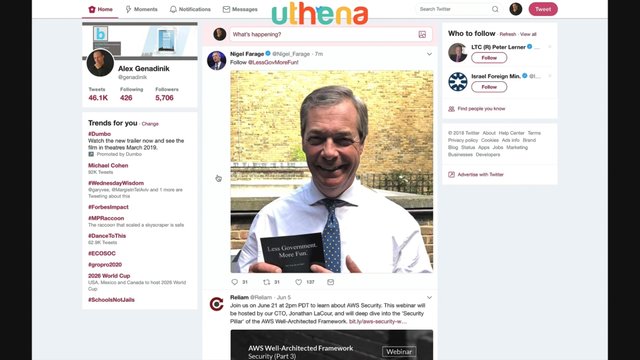
First of all, what we're going to do is examine the structure of a tweet. What I'd like you to do is follow my structure and without quoting the research, there's a lot of research behind how to tweet, and what works are tweets that are slightly below maximum length because guess what, all the other tweets take too long to read. And the tweets that are shorter are easier to consume, as you can see here.
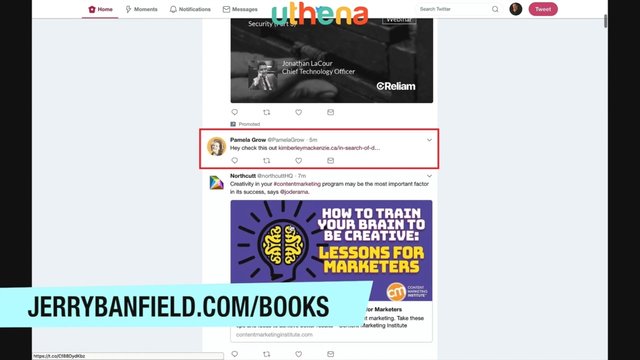
Much easier. And the eyes naturally go to places that are easier to read. So the shorter you can make your tweet the better. So what you want to do is the anatomy of a good tweet is few words followed by a link and then hashtag.
Okay, that's an ideal tweet.
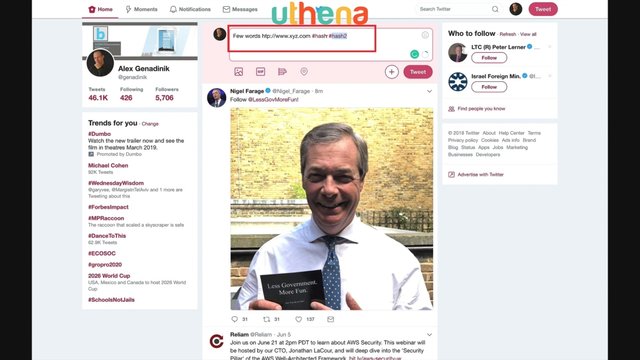
The ideal number of hashtags is two just because too many hashtags look a little spammy, makes your tweets hard to read. And only one or zero hashtags just doesn't give you the promotion that you need. So the structure of a tweet is like this. If you can add a photo or video, it takes a tremendous amount more space. So it's recommended that you also add a photo.
So this format will be ideal to get the attention of your tweet on people's feeds and then your hashtags, they can be strategically figured out. So for example, if you are promoting products, let's say promoting sunglasses, well one of your hashtags can be eBay. Also, what you can do is let Twitter auto correct you right?
You just type EB and then you say what's going on here, okay?So you know, you add another letter, okay. You're getting closer to eBay. Maybe there is something else on eBay? Okay, EBay auction. You might want to do eBay auction. And so you might let Twitter give you popular suggestions for whatever you're doing.
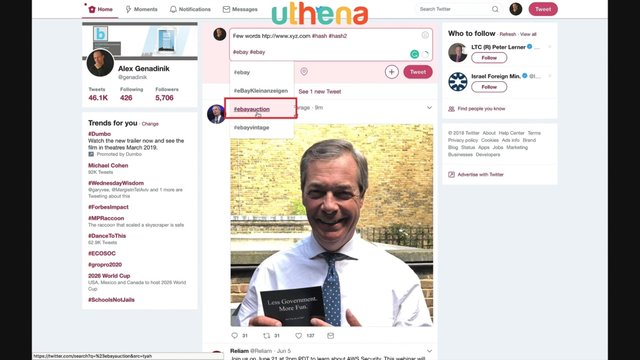
Other popular hashtags are things like deals, right? Then there's discounts. What these hashtags do, if you tweeted them, they would let you get discovered, because if you look at the left side here, you see these are the trending hashtags. And obviously, when I click on one it's almost like a conversation and you can come up in those hashtags, and it gives you an additional way to get discovered.
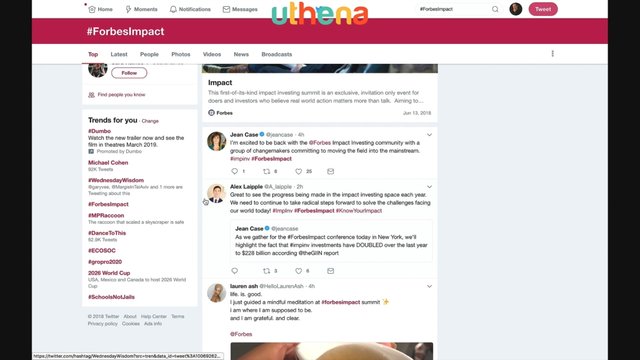
So if you're selling products, this is this will give you an additional way to get discovered. Now, obviously, it's going to be very hard to come up in a super popular hashtag. But if you're doing a less popular like sale, discount, or something about your product that you're selling on eBay, then you can stay on hashtags longer.
And the advanced strategy for hashtags is if you use the same hashtag all the time, let's say eBay, then the more you get retweeted on that hashtag, the more authority you can build for the hashtag. So what you will notice is some people, they really stay up high in the hashtags. For example, authoritative accounts, like this lady, Jeans Case, I don't really know her first time I'm seeing her, but you see, she's an authoritative account and she's got a lot of followers.
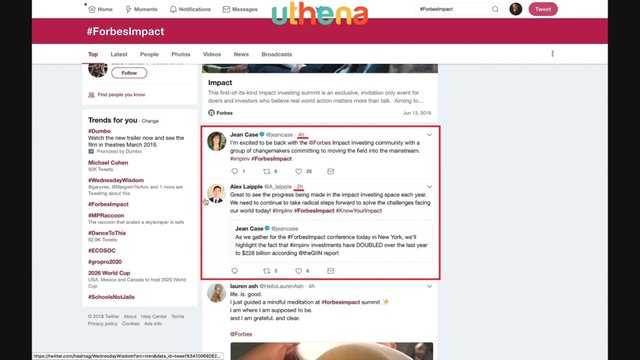
But you see, her tweet was made four hours ago and this person's to hours ago, where other people, if you scroll down, like way down, you see you get a lot of people who are two hours, two hours, 45 minutes.
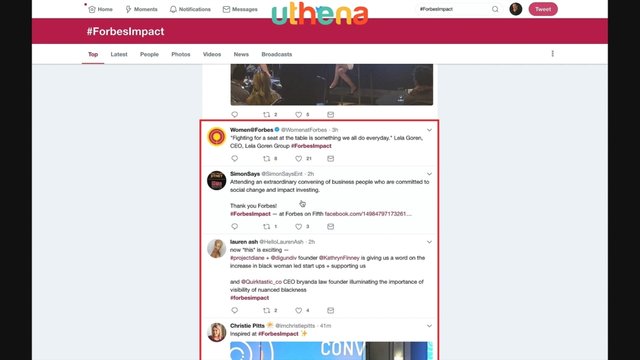
So a lot of the less popular tweets, they just quickly vanish. They just go down and they quickly disappear in search after a mere seconds, because there are so many people tweeting on popular hashtags that it is just impossible for Twitter to keep it up. But people who are authoritative, in Twitter, their tweets stay up longer, which means that they get discovered a lot more. And that's something long term that you can build up, is authority in Twitter so that your tweets stay up very far in the hashtag. Another thing you can do on Twitter is to automate your tweeting.
I use a tool like Socialoomph. I'll show it to you hear. It's not free. It's only a few bucks a month. Its $17 every two weeks,
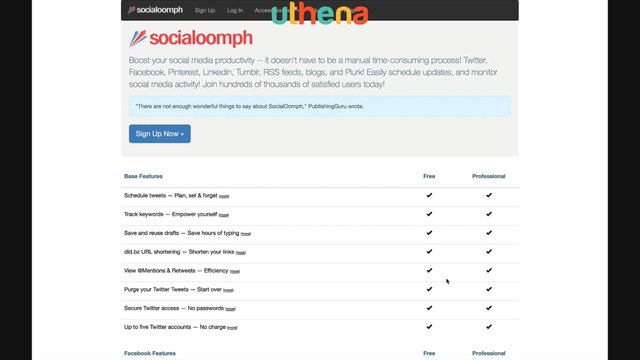
But you can preload all your tweets and you can set up the interval that you want between your tweets and so you don't have to revisit Twitter and spend time on it. You pre-load it once and you set it and forget it and your tweets just cycle. So that that means you're going to just waste less time.
It's a little bit more productive, even though it costs money. But if you're going to be serious about your Twitter marketing, its not a bad investment, especially if you can start making sales on Twitter, it will pay for itself.
So those are all the strategies on Twitter. What we covered is the structure of a tweet, the hashtags and Twitter automation. So it's a pretty quick overview. We went from pretty simple to advanced in just a few minutes.
One of the biggest challenges and problems that people encounter when they first publish their Amazon product for sale is they don't track it. And they don't even know if it's showing up for searches or what's happening.
GET MORE OF THIS COURSE
Would you like to continue learning about the 2019 Amazon SEO, Amazon Sales & Ads For Ecommerce Domination? If you are interested will you please buy the complete course, 2019 Amazon SEO, Amazon Sales & Ads For Ecommerce Domination, on the Uthena Education Platform..
You can also get the first 58 minutes of the course completely for free on YouTube.
Thank you for reading the blog post or watching the course on YouTube.
You may like to read this post: Google Analytics and Webmaster Tools for SEO in 2019!
I love you.
You’re awesome.
Thank you very much for checking out the 2019 Amazon SEO, Amazon Sales & Ads For Ecommerce Domination and I hope to see you again in the next blog post or video.
Love,
Jerry Banfield.
Posted from my blog with SteemPress : https://jerrybanfield.com/amazon-seo-sales-ads-ecommerce-2019/